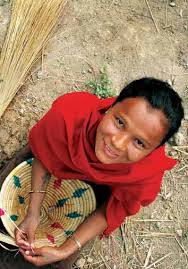The Tharu tribe inhabits areas along the right from Uttarkhand, to Uttar Pradesh and arts of Nepal, and about 3.5 lakh Tharus live in the Champaran District of Bihar, in the areas bordering Nepal.
Some people would want us to believe that the Tharu tribe originated from the Thar desert region of Rajasthan. Anthropologically, it’s evident that the Tharu are a hill people with Mongol- Chinese ancestry, and are in fact native to the regions where they are now settled.
The Tharus who live in the ‘Tharuhat’ areas of West Champaran are linguistically influenced by the Maithili, Bhojpuri, and Maghi dialects. One view is that the Tharu are not a ‘caste’ or ‘sub-caste’ as defined by the ‘brahmanical’ order, but in fact the product of miscellaneous cultural processes. In Bihar alone there are about 32 ‘sub-castes’ within the Tharu, but there is no rigid social stratification. In fact, the Tharu are better classified as a tribe in the universal sense of the term.

This, along with many other interesting facets of the socio-cultural reality of the Tharu community in Bihar are put together in an eighty two page book entitled, |थारु जनजातियों की प्रकृति प्रसूत संस्कृति | by Dr Jose Kalapura and Praveen Kumar Madhu, and published jointly by Xavier Institute of Social Research and Department of Art, Culture and Youth, Government of Bihar. This is part of an on-going ‘subaltern series’, about the less documented people and socio-cultural groups of Bihar. The series is in the form of ‘coffee table’ books in Hindi, but the purpose is to make available well-researched material to the reading public. The researchers point out that the entire series consists of well documented and meticulous research , and are not too happy with the ‘coffee table’ book tag.
As a matter of fact, the photographs in the book are typically unromantic and mundane, the kind of visuals that anthropologists and others of their ilk bring out.
The book is significant in more ways than one. It is the first book in Hindi supported by the Government of Bihar that deals specifically with the Tharus of Bihar, their origins, influences, beliefs, customs, and way of life.
[Jose Kalapura says: this is the third book on Tharus in Bihar. The first one by Praveer, the second authored by P. C. Dubey and published by XISR in 2009. There are two books and other documents on the Tharus in UP]
The book is ideal for school and college libraries, and the language is fairly easy to comprehend by those who have an average command of the Hindi language. The book is available at Xavier Institute of Social Research and may also be obtained from the Department of Art, Culture and Youth at Patna.


